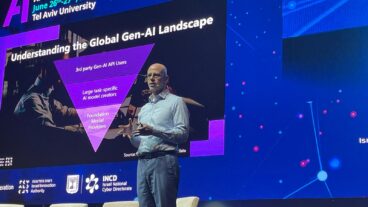Professor Eshel Ben-Jacob – We’re thinking of adding features to computers to make them more flexible and adaptable, like human brains. Mary Shelley’s Frankenstein might have been unprecedented in its time, but since then popular culture has been clogged with a fascination for the concept of artificial intelligence, from the eerily humanoid robots of The Twilight Zone to films like AI and Robocop. People can’t seem to get enough of the idea that advanced technology may one day create sentient life, but at the same time seem to dread the consequences of an apparent transgression against the laws of nature.
It may therefore come as a surprise to find that advances in the field of nano biotechnology are now taking place that have nothing to do with creating monsters. Instead, for Professor Eshel Ben-Jacob and his graduate student, Itay Baruchi of Tel Aviv University’s Department of Exact Sciences, the goal is to find treatments for neurological disorders such as epilepsy, Alzheimer’s and Parkinson’s disease.
With the use of chemical stimulation, Ben-Jacob and Baruchi discovered that they could trigger a man-made network of neurons to imprint patterns – the same process by which the brain creates memories. This discovery marks an early but crucial step toward the invention of a computer chip with the capability to create and store information the same way our own brains do. By linking the network of neurons to software which reads the neural activity, the network and the computer can work together to carry out tasks of which computers are currently incapable.
Their findings were published in the May issue of Physical Review E, and later made headlines inScientific American.
“Computers don’t have cognitive function because they lack plasticity – they are fixed,” Ben-Jacob told ISRAEL21c in an office lined with bookshelves where science texts and science fiction novels stand side by side.
“We’re therefore thinking of adding features to computers to make them more flexible and adaptable, like human brains.”
It’s the connection between the computer and the neural network, which would communicate with one another, that creates a new kind of machine. Ben-Jacob elaborates: “The network won’t replace the computer but it will do the softer cognitive functions of decision-making, interaction with the environment, and sound recognition.”
According to Baruchi, biological computing might also lead to technology that Microsoft has been working to achieve, without success: handwriting recognition, made possible by virtue of the biological system’s ability to detect patterns.
“The ability of the regular silicon-based computer to detect patterns is very low, and it needs a very sophisticated algorithm. With the biological system it’s very easy, because humans and animals can easily detect patterns,” said Baruchi, who has been working with Ben-Jacob for seven years.
In order to conduct experiments, neurons are placed in a Petri dish that is studded with electrodes on its base. The neurons spontaneously form a communicative network, and their activity generates pulses of voltage which are recorded by the electrodes. The electrodes are, in turn, connected to a computer that monitors and records the resulting patterns on its screen.
Scientists have long known that an artificial network of brain cells will create spontaneous patterns of activity, but they had not found a way to add new patterns. The common methods of experimentation on artificial networks of brain cells have been electrical stimulation and chemical stimulation. Baruchi explains that in his work with Ben-Jacob, chemical stimulation made sense because “neurons stimulate one another with chemical cues – so we thought we would [stimulate them] in the same way.”
Neurons are divided into two types: Excitatory neurons, which promote neurological activity, and inhibitory neurons, which reduce activity. According to Ben-Jacob, most researchers have tended either to focus on stimulating one or the other by “reward” (in the case of excitatory neurons) and “punishment” (in the case of inhibitory neurons). Baruchi and Ben-Jacob came up with the idea to suppress the inhibitory neurons with an injection of the chemical picrotoxin, which freed the excitatory neurons to create new patterns without hindrance. These new patterns lasted for days and in harmony with the already existing patterns.
“We did something new, we invented teaching by liberation,” says Ben-Jacob. “We gave the network the ability to act freely and generate new things by reducing inhibition during the limited time of stimulation. This helps to create a new pattern of firing.”
In the foreseeable future, the ability to imprint patterns in an artificial network of brain cells can be developed into various technologies. Ben-Jacob predicts that brain repair will be an important consequence for the treatment of neurological disorders like Alzheimer’s and Parkinsons. “Now that we have learned additional secrets [of how the brain stores information] we may be able to take a network, add stem cells and with the right stimulation can convert them into a functioning network,” says Ben-Jacob.
An even more long-term vision is to use these ideas for the treatment of epilepsy. Ben-Jacob describes the process by which this might be carried out: a recording of the brain activity of the epilepsy patient would be fed to the networks through a computer. The network would then communicate with the human brain in order to correct the epilepsy.
The science fiction aspect of the discovery rears its head when Ben-Jacob describes other potential advances, such as “cybrids” (cyborg-hybrids) that can learn to carry out specific tasks. His idea is that the networks, which are biological and therefore react as humans do, will be connected with co-evolvable computer software, so that the network and the software can evolve together to learn tasks. Exposing the network to various toxins would produce specific patterns from the neurons, which the computer would then record and learn; a technology which would lead to the creation of machines that are capable of identifying toxins in the environment.
Ben-Jacob sees many potential possibilities, and suggests: “We can connect the network with retina cells so it can detect light, for building a robot that can look and see… a machine that shares similar capabilities with the human brain.”![]()
Slashdot It!![]()












